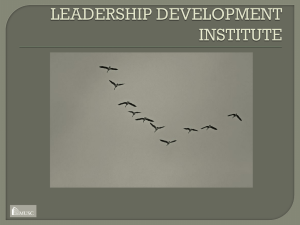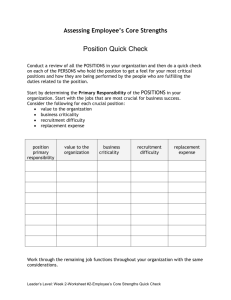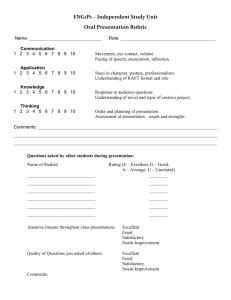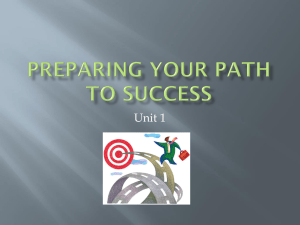Rath, T., & Conchie, B. (2008). Strengths based leadership.
advertisement
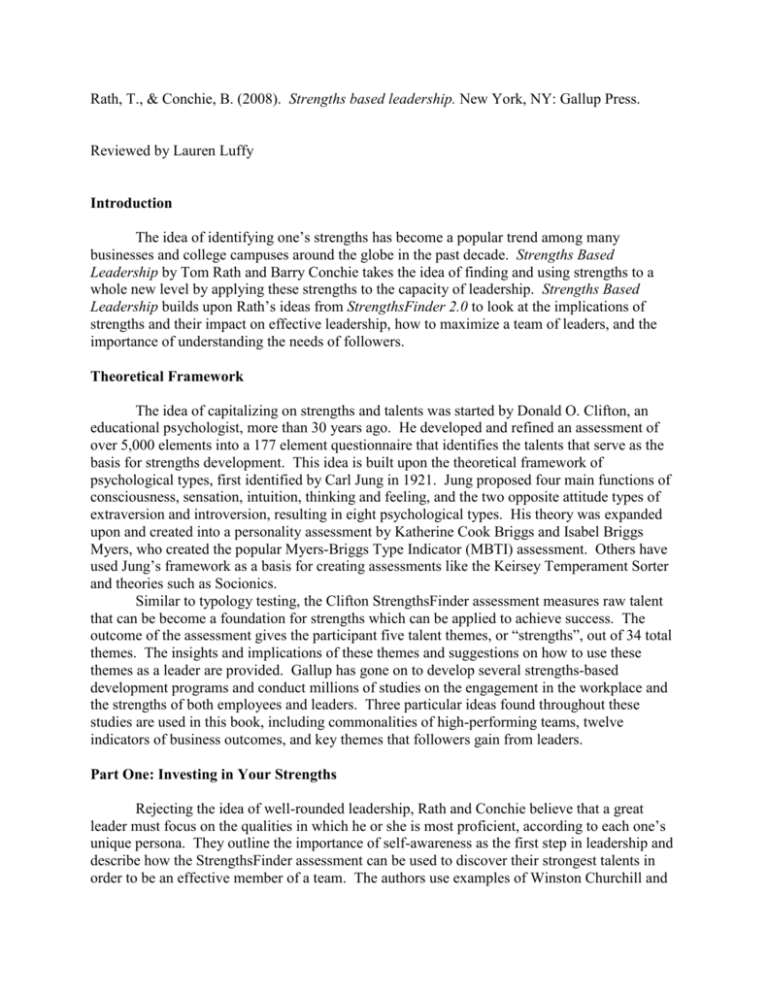
Rath, T., & Conchie, B. (2008). Strengths based leadership. New York, NY: Gallup Press. Reviewed by Lauren Luffy Introduction The idea of identifying one’s strengths has become a popular trend among many businesses and college campuses around the globe in the past decade. Strengths Based Leadership by Tom Rath and Barry Conchie takes the idea of finding and using strengths to a whole new level by applying these strengths to the capacity of leadership. Strengths Based Leadership builds upon Rath’s ideas from StrengthsFinder 2.0 to look at the implications of strengths and their impact on effective leadership, how to maximize a team of leaders, and the importance of understanding the needs of followers. Theoretical Framework The idea of capitalizing on strengths and talents was started by Donald O. Clifton, an educational psychologist, more than 30 years ago. He developed and refined an assessment of over 5,000 elements into a 177 element questionnaire that identifies the talents that serve as the basis for strengths development. This idea is built upon the theoretical framework of psychological types, first identified by Carl Jung in 1921. Jung proposed four main functions of consciousness, sensation, intuition, thinking and feeling, and the two opposite attitude types of extraversion and introversion, resulting in eight psychological types. His theory was expanded upon and created into a personality assessment by Katherine Cook Briggs and Isabel Briggs Myers, who created the popular Myers-Briggs Type Indicator (MBTI) assessment. Others have used Jung’s framework as a basis for creating assessments like the Keirsey Temperament Sorter and theories such as Socionics. Similar to typology testing, the Clifton StrengthsFinder assessment measures raw talent that can be become a foundation for strengths which can be applied to achieve success. The outcome of the assessment gives the participant five talent themes, or “strengths”, out of 34 total themes. The insights and implications of these themes and suggestions on how to use these themes as a leader are provided. Gallup has gone on to develop several strengths-based development programs and conduct millions of studies on the engagement in the workplace and the strengths of both employees and leaders. Three particular ideas found throughout these studies are used in this book, including commonalities of high-performing teams, twelve indicators of business outcomes, and key themes that followers gain from leaders. Part One: Investing in Your Strengths Rejecting the idea of well-rounded leadership, Rath and Conchie believe that a great leader must focus on the qualities in which he or she is most proficient, according to each one’s unique persona. They outline the importance of self-awareness as the first step in leadership and describe how the StrengthsFinder assessment can be used to discover their strongest talents in order to be an effective member of a team. The authors use examples of Winston Churchill and Mahatma Gandhi to emphasize that all leaders have very different strengths, and those who are most aware become the most successful. Rath and Conchie continue by discussing the development of the StrengthsFinder and how it can dramatically increase work production. They detail how the assessment can lead to increased self-confidence and morale and the engagement and productivity of an entire organization and may have long term implications, such as higher income levels and less health problems in the future. Part Two: Maximizing Your Team The second section of the book emphasizes the importance of creating a team of leaders based on their strengths instead of their expertise in one field. Conducting interviews with thousands of executive teams, Gallup found that the most cohesive and successful teams were well rounded in that they possessed leaders in each of four broader categories of strengths. The four classifications derived from these studies were executing, influencing, relationship building, and strategic thinking. The 34 resulting themes of the StrengthsFinder assessment are each sorted into one of these four categories and leaders are considered to be dominant in the category in which the majority of their strengths fall. Executors “know how to make things happen” and are best at implementing solutions, while influencers are good at selling ideas and reaching a broader audience. Relationship builders create a stronger organization through personal connection and care, while strategic thinkers absorb and analyze information well and think towards the future. The most successful teams have a representation of all four categories in order to create a well-rounded membership that can compensate for each other’s weaknesses. Rath and Conchie focus on four leaders of prominent organizations around the world to illustrate each of the four categories in a practical way. They illustrate the personality of Wendy Kopp, the founder and CEO of Teach for America, Simon Cooper, the president of The RitzCarlton Hotel Company, Mervyn Davies, the chairman of one of the world’s largest banks, the Standard Charted Bank, and Brad Anderson, the CEO of Best Buy, and show how each of them have become successful by capitalizing on their strengths. Rath and Conchie also tell of other successful figures, such as Phil Cordell, president of Hampton Hotels, who surround themselves with leaders of different strengths, but also ensure that each member of the team understands the strengths of one another in order to be able to work together. The authors continue by citing and expanding upon Gallup studies which have determined five principles of strong teams: 1) focusing on results, 2) prioritizing and moving forward on what’s best for the organization, 3) having members who are satisfied with their personal lives as well as their employment, 4) embracing diversity and important characteristics of teams that allow them to become “magnets for talent” and 5) continuing to invest in strengths and relationships. Part Three: Understanding Why People Follow Leaders cannot become leaders without followers. However, the prior studies have a large emphasis on leaders and do not take followers into consideration. To understand the perceptions of leaders, Gallup conducted a special poll asking followers about a leader they have been influenced by in their daily life and three words that describe the impact that these leaders have made. There were four words that followers overwhelmingly mentioned most often: trust, compassion, stability and hope. Trust, while increasing speed and efficiency, is most closely linked to engagement in the workplace, as trust in the leadership of the organization increases engagement sixfold. Compassion creates a more productive and profitable organization with members who are much more likely to stay with the organization and customers who are more engaged. Stability in both the organization and its finances ensures employees a steady paycheck and organizations that are more transparent and give regular updates are more likely to find confident employees and efficient growth. Hope and the feeling of enthusiasm about the future of the organization is a clear indicator of engagement among employees because without it they feel helpless. While most leaders are more focused on responding, rather than initiating, identifying opportunities for the organization is an important element in creating hope and optimism for the future. Additional Resources An access code that comes with the purchase of each book allows the reader to take the most recent version of the StrengthsFinder assessment. The results of the assessment include the reader’s top five strengths, as well as a customized strengths-based leadership guide with suggestions for implementation as a leader and examples of each theme. Even if the reader has already taken the assessment, he or she can log on and receive the leadership guide portion that corresponds to his or her top five strengths. Similar to content of StrengthsFinder 2.0, Strengths Based Leadership devotes more than half of the text to an entire section of information detailing the characteristics of each of the 34 possible strengths and how to lead with each of the strengths in response to the four needs of followers in order to build trust, show compassion, provide stability and create hope. This information allows for greater self-awareness and identification of current tendencies and allows the reader to capitalize on the practices in which they already engage. For each of the 34 strengths, the book also provides tips on working with others who possess each particular strength. This is useful in being able to recognize and understand the qualities of other leaders and members of a surrounding team. The last section of the book provides greater detail of the research behind the development and application of StrengthsFinder, Gallup’s research on engaging team members, and the studies supporting the findings of the four themes of followers. At the end are detailed references of each poll, diagram, study, and interview noted in the text according to page number. Target Audience While many examples and references in the book are taken from Fortune 500 Company Presidents and Chief Executive Officers, the book is written for anyone who would like to be a leader. However, much of the research is based on data from business executives around the world and results are often in the context of employer-employee relationships and employee satisfaction, so it may be more difficult for those in other contexts, such as students, to understand and apply the concepts in a different context. Practical Application The text can be easily applied to leadership and management teams in companies of all sizes. As many of the previous books by Tom Rath, it would be a good use of individual development skills for those who have taken the StrengthsFinder assessment. The information could also be presented as a good follow-up for those who have some background knowledge on strengths-based development. It would be good material to focus on in a conference presentation or leadership team group discussion, as it focuses on qualities of teamwork and how to maximize efficiency and strengths in a group setting. There could be other difficulties in applying it to a student leadership program, as it does not have any direct examples of student-based leadership or even general applications of teamwork or community-based work. All statistics and applications refer to a corporate atmosphere, which may make it more difficult for students to connect the ideas to their own lives. While students might identify with their strengths, the text does not explicitly show them how to incorporate these strengths into use in leadership. The previous perceptions of leadership will also affect how students may interpret their strengths and they may have difficulty incorporating certain strengths into their leadership style, especially if it is already developed. However, the main ideas of the text could be a strong foundation for any student leadership program, especially as a compliment to the use of the StrengthsFinder or StrengthsQuest assessment. If applied in a relatable way for students, it could teach values that can develop student leaders to be able to lead more effectively both inside and outside the classroom, whether in team projects, student organizations, or informal groups. Critique The authors have a strong belief in the power of capitalizing on the strengths of a person, rather than focusing on improving weaknesses. The book expands greatly from its predecessors such as Now, Discover Your Strengths and StrengthsFinder 2.0 to include examples of developing as a leader and understanding how strengths play into team dynamics. Under Rath and Conchie’s framework which states that focusing on strengths increases self-confidence, while focusing on weaknesses increases frustration, hopelessness, and disappointment, the concept makes sense and resonates with readers. It is easy for students who are new to leadership development to comprehend and would be an appropriate framework to use with freshmen and new student leaders, coupled with other leadership models. The strongest part of the book takes the ideas of followers into account and applies strengths to the four needs of followers in a practical way. This is new information for the discipline that often goes unnoticed. Leadership programs typically focus on the development of the leader and strategies that he or she can use in practical situations, but rarely considers the point of view of the follower or the essential values that need to be communicated to followers. While the concept of strengths is a great self-awareness tool for students, the words identified as strengths may not be clearly understood by participants. Because the strengths are not defined anywhere in the book, students may misinterpret the meaning of the strengths and could have difficulty in developing them further. As with any type of inventory, the participant may disagree with their results and self-identify with another set of items, causing confusion and the potential reversal of intended outcomes. The strengths framework avoids the negative implications of strengths and the fact that along with strengths, people have weaknesses as well. Rath and Conchie do not address ways in which to identify or focus on weaknesses or address the implications that weaknesses may have on leadership skills and development. In dealing with student development, this is a large drawback, as not only are weaknesses being disregarded, but there is less development and growth to be found when focusing on strengths over weaknesses. This idea of ignoring weaknesses and only focusing on strengths does not give students a realistic view of development and could stunt student growth in the future. The book appears very credible, as many of the statistics in the book come from over 25 years of Gallup studies evaluating leaders and their strengths. Other qualitative information comes from over 20,000 personal interviews conducted by Donald Clifton, the father of strengths-based psychology. However, as far as the reader can tell, the statistical information applies only to corporate atmospheres, which limits the application as well as the transferability of the results and the basis for the book. The information would become more credible and more diversified in its application if Gallup were to conduct these same questionnaires and interviews across disciplines, as opposed to focusing only on business management. This narrowed perspective limits the application as well as the scope of the audience. The information, while easy to comprehend and fun to read, only scratches the surface of the ideas and applications of strengths-based leadership. It does not take any idea into great depth and would be useful if it could be applied to a broader spectrum of disciplines. Reviewer Lauren Luffy is currently a graduate student in the College Student Personnel program at Bowling Green State University (BGSU) and works as a graduate assistant in the Office of Campus Activities at BGSU. She has taken multiple leadership classes and is currently teaching an elective leadership class to undergraduate students at BGSU. Lauren graduated from The Ohio State University with a Bachelor’s of Science in Architecture in 2010. Luffy, L. (2011). Using your strengths in leadership. [Review of the book Strengths based leadership, T. Rath and B. Conchie]. National Clearinghouse for Leadership Programs. Retrieved from http://www.nclp.umd.edu
